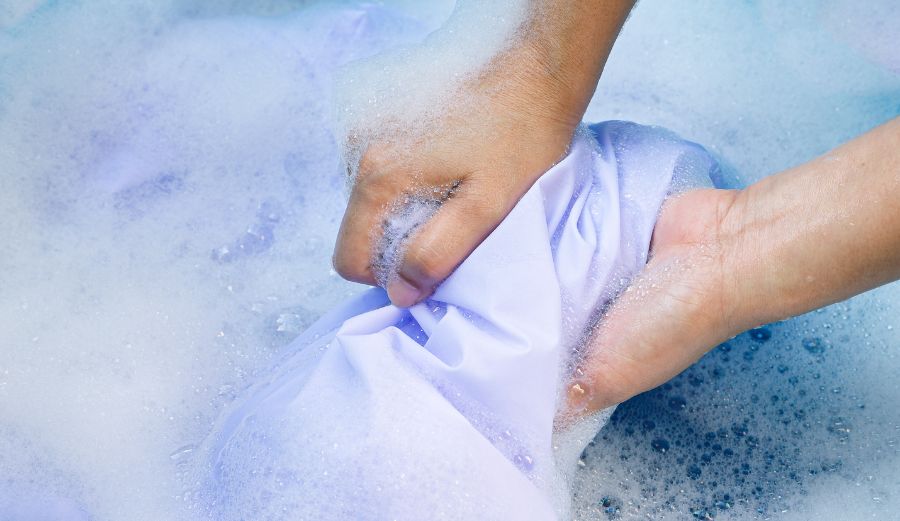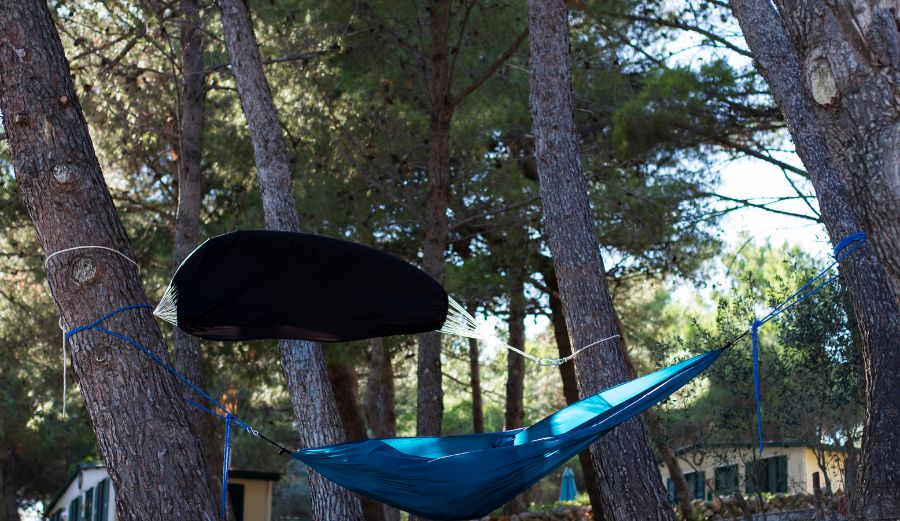How to Wash a Hammock: Your Complete Cleaning Guide
Washing a hammock is crucial for maintaining its comfort, durability, and hygiene. Regular cleaning prevents mold, mildew, and dirt buildup, ensuring a safe and enjoyable outdoor relaxation experience while extending the hammock’s lifespan.

Maintaining the cleanliness of your hammock is essential to uphold its durability and guarantee optimal comfort. In this comprehensive guide on how to wash a hammock, we will walk you through the crucial steps.
We’ve got you covered, from prepping the hammock and choosing the suitable washing methods to ensuring proper maintenance. Explore the critical points outlined here to ensure your hammock remains a pristine and inviting relaxing oasis.
Table of Contents
ToggleUnderstanding Hammock Materials

Hammocks come in various materials, such as cotton, polyester, and nylon, each with distinct properties affecting their care and cleaning.
Types of Hammock Materials:
Cotton: Cotton hammocks are soft and breathable, perfect for comfort. However, they can retain moisture and require careful drying to prevent mold and mildew.
Polyester: Polyester hammocks are durable and weather-resistant, making them suitable for outdoor use. They resist fading and are relatively low-maintenance, but cleaning helps maintain their appearance.
Nylon: Nylon hammocks are lightweight and great for travel. They’re less prone to mold but can accumulate dirt. Regular cleaning prevents dirt buildup and extends their lifespan.
Impact of Material on Cleaning:
Gentle Cleaning for Cotton: Due to cotton’s absorbent nature, gentle cleaning methods are essential. Avoid harsh detergents and high-pressure washing, which can weaken the fibers and compromise the hammock’s integrity.
Moderate Cleaning for Polyester: Polyester hammocks are more resilient. While avoiding abrasive cleaners, you can use mild detergents and a soft brush for more thorough cleaning, helping remove dirt and stains effectively.
Cleaning Nylon with Care: Nylon hammocks are versatile. Clean with a mild detergent, avoiding excessive scrubbing to prevent damage to the delicate fabric. Rinse thoroughly to remove soap residue.
By recognizing the material of your hammock, you can tailor your cleaning routine to maintain its quality and extend its lifespan effectively.
Preparing for Cleaning

Before cleaning your hammock, taking a few essential steps ensures the process goes smoothly.
1. Check Manufacturer’s Recommendations: Start by checking any care instructions provided by the manufacturer. Different hammock materials may have specific cleaning guidelines that can help you avoid unintentional damage. Adhering to these recommendations ensures you maintain your hammock’s quality.
2. Gather Necessary Tools and Supplies: To effectively clean your hammock, you’ll need the following tools and supplies:
- Mild Detergent: Choose a gentle detergent that won’t harm the fabric’s integrity. Avoid harsh chemicals that could weaken the material over time.
- Soft Brush: Use a soft-bristled brush to gently scrub away dirt and stains. This helps prevent damaging the hammock fibers while still effectively removing debris.
- Water Source: Ensure you can access clean water for the rinsing process. A hose, bucket, or even a bathtub can work depending on the size of your hammock.
- Container for Soaking: If your hammock requires soaking, prepare a large container or basin to comfortably submerge the fabric.
- Clean Towels: Keep clean towels nearby for blotting excess water and aiding in drying.
By following these steps and having the necessary tools, you’re setting yourself up for a successful and thorough hammock cleaning session.
Removing Debris

Clearing your hammock of leaves, dirt, and debris before washing is crucial to ensure effective cleaning and maintain its longevity.
Importance of Debris Removal: Leaves, dirt, and other particles can embed in the fabric over time, leading to staining and potential deterioration. Removing these particles before washing creates a clean canvas for the cleaning process to be more effective.
Step-by-Step Debris Removal:
- Shake Gently: Start by holding the hammock at its endpoints. Give it a gentle shake to dislodge larger debris like leaves and twigs. This helps prevent them from getting caught in the fabric during washing.
- Brush Lightly: Use a soft-bristled brush to lightly sweep across the surface of the hammock. Brush in the direction of the fabric’s weave to avoid damaging the fibers. This step helps remove finer particles like dust and dirt.
- Inspect and Repeat: Inspect the hammock’s surface for any remaining debris. If you spot any stubborn particles, continue brushing gently until they are entirely dislodged.
- Turn and Repeat: Flip the hammock over to its other side and repeat the shaking and brushing process. Ensure both sides are free from debris before proceeding to wash.
By removing debris using these simple steps, you’re preparing your hammock for a thorough and effective cleaning, enhancing its overall appearance and durability.
Hand-Washing a Hammock

Hand-washing is a careful and effective method for delicate hammocks that ensures proper cleaning without compromising the fabric’s integrity.
Process of Hand-Washing:
1. Create a Cleaning Solution:
- Fill a large basin or container with lukewarm water.
- Use a modest quantity of mild detergent, being cautious not to overdo it, as excessive detergent can be challenging to rinse thoroughly.
2. Soak the Hammock:
- Submerge the hammock in the cleaning solution, gently pressing it to ensure even soaking.
- Allow the hammock to soak for about 15 to 20 minutes. This helps loosen dirt and stains.
3. Scrub Gently:
- Using a soft brush, lightly scrub the fabric. Work circularly and pay extra attention to any stained or soiled areas.
- Avoid scrubbing too vigorously, as this can damage the delicate fibers.
4. Rinse Thoroughly:
- Empty the basin and refill it with clean, lukewarm water.
- Rinse the hammock by gently agitating it in the water, removing any soap residue.
5. Remove Excess Water:
- Carefully lift the hammock from the water and support it with both hands to prevent stretching or tearing.
- Gently squeeze out excess water by pressing the fabric between clean towels.
6. Air-Dry Properly:
- Hang the hammock in a shaded area or indoors to prevent direct sunlight exposure, which can fade the fabric.
- Allow the hammock to air-dry completely. Avoid using a dryer, as the heat can damage the material.
Emphasize Gentle Care: Maintaining a gentle touch to safeguard the hammock’s delicate fibers throughout the process. Harsh scrubbing or twisting can lead to fraying or weakening. Hand-washing is a meticulous but worthwhile method to extend the life of your delicate hammock while ensuring it remains pristine and inviting.
Machine-Washing a Hammock

For robust hammocks made of machine-safe materials, machine-washing can be a convenient cleaning option, provided you follow these steps carefully.
Instructions for Machine-Washing:
- Preparation:
- Ensure all hooks or attachments are removed from the hammock to prevent tangling or damage to the machine.
- Select Proper Settings:
- Choose the gentle cycle on your washing machine to minimize agitation and prevent potential stress on the hammock’s fabric.
- Opt for cold water to prevent color fading and fabric shrinking.
- Protective Measures:
- Place the hammock inside a pillowcase or a mesh wash bag. This extra layer of protection prevents the hammock from getting tangled with other items or potentially snagging on the washing machine’s drum.
- Add Mild Detergent:
- Use a small amount of mild detergent to avoid excessive sudsing, which can be difficult to rinse out thoroughly.
- Load Carefully:
- Place the pillowcase or wash bag with the hammock into the washing machine. Be mindful not to overload the machine, allowing the hammock to move freely during washing.
- Start the Cycle:
- Begin the gentle cycle with cold water as per your machine’s settings.
- Extra Rinse:
- If your washing machine offers an extra rinse option, consider using it to ensure all detergent residue is thoroughly removed.
- Air-Drying:
- After the cycle is complete, remove the hammock from the pillowcase or wash bag.
- Hang the hammock to air-dry in a shaded or well-ventilated area. Avoid direct sunlight, which can lead to fading and damage.
By adhering to these machine-washing instructions and taking precautions, you can effectively clean sturdy hammocks while safeguarding their structural integrity and appearance.
Drying Methods

Properly drying your hammock after washing is vital to maintain its quality and extend lifespan. Explore the various drying options and techniques below.
1. Air-Drying: Air-drying is a gentle method that preserves the fabric’s integrity and prevents damage.
- Advantages: It minimizes stress on the fibers and helps maintain the hammock’s shape.
- Caution: Avoid hanging the hammock under direct sunlight, which can lead to fading and weakening of the material over time.
2. Machine-Drying: While machine-drying is generally not recommended, some materials may tolerate it under specific conditions.
- Caution: If machine-drying is permissible, use the lowest heat setting to prevent shrinkage or damage.
- Note: Even with machine-safe materials, air-drying is often the safer option.
Protecting Against Sunlight: Direct sunlight exposure can cause colors to fade and weaken the fabric. Air-drying and machine-drying should be done in shaded or indoor areas to maintain the hammock’s appearance and durability.
Tips for Proper Air-Drying:
- Hang Evenly: Hang the hammock evenly to prevent uneven stretching or distortion of the fabric.
- Use Supportive Points: Ensure the hammock is supported at multiple points along its length to distribute the weight evenly.
- Avoid Overstretching: Do not hang the hammock too taut, as this can strain the suspension points.
Remember, proper drying methods are vital in preserving your hammock’s quality. Choose how suits your hammock’s material and follow the precautions to enjoy prolonged comfort and relaxation.
Maintenance Tips

Caring for your hammock goes beyond cleaning. These maintenance practices help ensure its longevity and consistent comfort.
1. Regular Cleaning: Keep your hammock clean by following proper cleaning techniques. Regular removal of dirt, debris, and stains prevents deterioration over time.
2. Storage During Harsh Weather:
- Rainy Seasons: Store your hammock indoors during heavy rain or storms to prevent excess moisture and potential mildew growth.
- Winter Months: If you live in a region with cold winters, consider storing the hammock indoors to shield it from freezing temperatures that might weaken the fabric.
3. Periodic Inspection:
- Check Suspension Points: Regularly examine the suspension points, such as hooks and ropes, for signs of wear or weakening. Replace any worn-out components promptly.
- Inspect Fabric: Look for fraying, thinning, or discoloration of the fabric. Address these issues before they escalate.
4. Proper Folding and Rolling:
- Folding: When not used, fold the hammock carefully to avoid tangling or twisting the ropes or fabric.
- Rolling: Alternatively, roll the hammock neatly to prevent unnecessary creasing.
5. Avoid Sharp Objects:
- Pets: Keep pets away from the hammock to prevent accidental scratching or damage.
- Sharp Objects: Avoid contact with sharp objects that could puncture or tear the fabric.
By adhering to these maintenance tips, you can significantly extend your hammock’s lifespan and continue to enjoy its relaxing benefits for years to come.
Storing the Hammock

Proper storage ensures your hammock remains in top condition when not in use. Follow these guidelines to maintain its quality.
1. Clean and Dry: Ensure the hammock is completely clean and dry before storing. Any residual moisture can lead to mold or mildew growth during storage.
2. Choose a Dry Area:
- Opt for a cool, dry, and well-ventilated storage space.
- Avoid areas prone to dampness or extreme temperature fluctuations.
3. Folding or Rolling:
- Folding: If your hammock is relatively compact, fold it neatly along its length. Fold the sides inward to prevent tangling.
- Rolling: Alternatively, roll the hammock from end to end, keeping it taut but tight enough. This prevents the twisting of ropes or fabric.
4. Use Storage Accessories:
- Storage Bag: Consider using a dedicated storage bag to protect the hammock from dust and potential damage.
- Hooks and Attachments: If removable, store hooks and attachments separately in a labeled bag to prevent loss.
5. Elevate Off the Ground:
- Hang the folded or rolled hammock on hooks or a sturdy rod to keep it off the ground.
- This prevents contact with moisture and pests.
6. Periodic Inspection:
- Occasionally check the stored hammock for signs of moisture or pest intrusion.
- If any issues are identified, address them promptly.
By storing your hammock correctly, you safeguard its fabric and components, ensuring it remains ready for your next relaxing moment without worrying about tangling or damaging.
Troubleshooting

Are you encountering issues while cleaning your hammock? Here’s how to handle common problems and challenges.
1. Mildew or Mold:
- Solution: Mix equal water and white vinegar in a spray bottle. Apply the solution to the affected area, scrub gently with a soft brush, and rinse thoroughly. Ensure the hammock is completely dry before storing.
2. Stubborn Stains:
- Solution: Create a paste using baking soda and water. Apply it to the stain, let it sit for a few hours, then gently scrub and rinse. Repeat if necessary.
3. Color Bleeding:
- Solution: To prevent color bleeding, always test a small, inconspicuous area with the cleaning solution before proceeding.
4. Rope Fraying:
- Solution: If you notice fraying in the rope, trim the frayed ends carefully to prevent further damage. Knot the ends to secure them.
5. Fabric Tears:
- Solution: Use a fabric adhesive or a patch kit for the hammock’s material for minor tears. If the tear is extensive, consider seeking professional repair.
6. Persistent Odor:
- Solution: Air-dry the hammock thoroughly in a well-ventilated area. Mild odors can dissipate naturally. Avoid using strong chemicals, as they might affect the fabric’s integrity.
7. Challenges During Cleaning:
- Solution: If the fabric becomes tangled during washing, pause the cycle and carefully untangle it to prevent damage.
- Solution: If soap residue remains after rinsing, re-rinse the hammock in clean water.
Remember, troubleshooting is a part of maintaining your hammock’s condition. Addressing issues promptly and using appropriate solutions will help you enjoy a clean, comfortable, and long-lasting hammock experience.
Wrap Up
In this comprehensive guide on washing and maintaining a hammock, we’ve covered essential steps to ensure your outdoor haven remains a source of comfort and relaxation for years to come.
From understanding different materials and choosing the suitable cleaning method to protecting against weather and inspecting for wear, each step contributes to the hammock’s longevity and your continued enjoyment.
Proper Cleaning and Longevity: Regular cleaning and meticulous maintenance are paramount in preserving the hammock’s comfort, appearance, and durability.
By following these guidelines, you’re enhancing your relaxation and investing in a hammock that remains inviting and reliable throughout its lifespan. Remember, a well-cared-for hammock rewards you with endless hours of tranquility and rejuvenation.
Share Your Tips: We value your insights! Feel free to share your hammock cleaning and maintenance tips in the comments below. Your experiences can help others enjoy their hammocks to the fullest.
